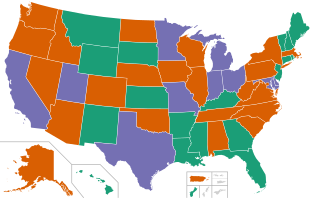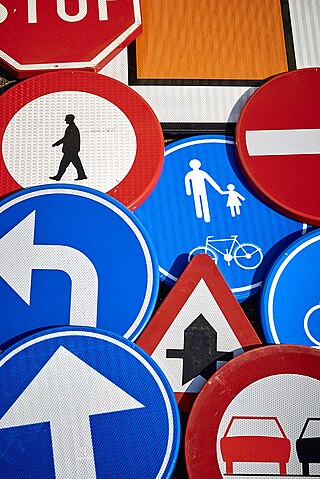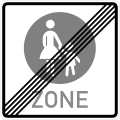
Traffic lights, traffic signals, or stoplights – also known as robots in South Africa – are signalling devices positioned at road intersections, pedestrian crossings, and other locations in order to control the flow of traffic.

A warning sign is a type of sign which indicates a potential hazard, obstacle, or condition requiring special attention. Some are traffic signs that indicate hazards on roads that may not be readily apparent to a driver.

Road signs in the United Kingdom and in its associated Crown dependencies and overseas territories conform broadly to European design norms, though a number of signs are unique: direction signs omit European route numbers and road signs generally use the Imperial System of units, unlike the rest of Europe. Signs in Wales and parts of Scotland are bilingual.
Road signs in Sweden are regulated in Vägmärkesförordningen, VMF (2007:90), and are to be placed 2 metres from the road with the sign 1.6 m from the base for motorized roads. Except for route numbers, there are a maximum of three signs on a pole, with the most important sign at the top. All signs have a reflective layer added on selected parts of the sign as is custom in European countries; most larger signs also have their own illumination.
Road signs in Singapore closely follow those laid down in the traffic sign regulations used in the United Kingdom, although a number of changes over the years have introduced some slight deviations that suit local road conditions. Road signs in Singapore conform to the local Highway Code under the authority of the Singapore Traffic Police.

Road signs in Norway are regulated by the Norwegian Public Roads Administration, Statens vegvesen.

Iceland never ratified the Vienna Convention on Road Signs and Signals, but road signs in Iceland conform to the general pattern of those used in most other European countries, with certain design elements borrowed from Danish and Swedish practice. Signs tend to be more sparsely employed than in other European countries, especially in rural areas.

Road signs in Italy conform to the general pattern of those used in most other European countries, with the notable exception that the background of motorway (autostrada) signs is green and those for 'normal' roads is blue. They are regulated by the Codice della Strada and by the Regolamento di Attuazione del Codice della Strada in conformity with the Vienna Convention on Road Signs and Signals.

In the United States, road signs are, for the most part, standardized by federal regulations, most notably in the Manual on Uniform Traffic Control Devices (MUTCD) and its companion volume the Standard Highway Signs (SHS).
The design of road signs in Poland is regulated by Regulation of the Ministers of Infrastructure and Interior Affairs and Administration on road signs and signals. The Annex 1 to the regulation describes conditions related to usage of the road signs – size, visibility, colors and light reflections, typeface and text, criteria of choosing the type of foil to signs faces, colorful specimens and schematics.

Road signs in Israel are decided by the Ministry of Transportation in the Division of Transportation Planning, most recently set forth in June 2011.
Road signs in Finland are formerly regulated in Tieliikenneasetus (5.3.1982/182), but is currently regulated in Siirtymäsäännökset (8.5.2020/360).

In Japan, road signs are standardized by the "Order on Road Sign, Road Line, and Road Surface Marking (道路標識、区画線及び道路標示に関する命令)" established in 1968 with origins from the Tokyo Metropolitan Police Department's "Order on Standardization of Road Sign" of 1934 and the Home Ministry of Japan's "Order on Road Signs" of 1942. The previous designs have been used since 1986 after several amendments of order.

Road signs in Switzerland and Liechtenstein generally conform to the 1968 Vienna Convention on Road Signs and Signals.

Road signs in Mauritius are standardised traffic signs used in Mauritius according to the Traffic Signs Regulations 1990. They are heavily modelled on road signs in the United Kingdom, since Mauritius is a former British colony. Mauritius has left-hand traffic.

Road signs in Ukraine are governed by a combination of standards set out by the Vienna Convention on Road Signs and Signals, the European Union (EU), and Ukraine Transport and Roads Agency. Ukrainian signs are similar to the signs of other post-Soviet states and are set out in 7 separate categories based on meaning: Warning, priority, prohibitory, mandatory, information, guide, and additional plates.

Road signs in Hong Kong are standardised by the Transport Department. Due to being a former British territory, the road signage in Hong Kong is similar to road signs in the United Kingdom, with the addition of Traditional Chinese characters.
These road signs are used in France, and can also be found in some overseas territories of France.

This page lists the traffic signs used in Belgium, as included in the traffic code.
Road signs in the Republic of Bulgaria were introduced by the Road Traffic Act and are regulated by:


















